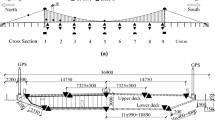Abstract
This paper focuses on developing an online structural condition assessment technique using long-term monitoring data measured by a structural health monitoring system. The seasonal correlations of frequency-temperature and beam-end displacement-temperature for the Runyang Suspension Bridge are performed, first. Then, a statistical modeling technique using a six-order polynomial is further applied to formulate the correlations of frequency-temperature and displacement-temperature, from which abnormal changes of measured frequencies and displacements are detected using the mean value control chart. Analysis results show that modal frequencies of higher vibration modes and displacements have remarkable seasonal correlations with the environmental temperature and the proposed method exhibits a good capability for detecting the micro damage-induced changes of modal frequencies and displacements. The results demonstrate that the proposed method can effectively eliminate temperature complications from frequency and displacement time series and is well suited for online condition monitoring of long-span suspension bridges.
Similar content being viewed by others
References
Cornwell P, Farrar CR and Doebling SW, et al. (1999), “Environmental Variability of Modal Properties,” Experimental Techniques, 23(6): 45–48.
Ding YL and Li AQ (2007), “Structural Health Monitoring of Long-span Suspension Bridges Using Wavelet Packet Analysis,” Earthquake Engineering and Engineering Vibration, 6(3): 289–294.
Ding YL, Li AQ and Liu T (2008), “Environmental Variability Study on the Measured Responses of Runyang Cable-stayed Bridge Using Wavelet Packet Analysis,” Science in China Series E: Technological Sciences, 51(5): 517–528.
Fuqate ML, Sohn H and Farrar CR (2001), “Vibrationbased Damage Detection Using Statistical Process Control,” Mechanical Systems and Signal Processing, 15(4): 707–721.
Hua XG, Ni YQ, Ko JM, et al. (2007), “Modeling of Temperature-frequency Correlation Using Combined Principal Component Analysis and Support Vector Regression Technique,” Journal of Computing in Civil Engineering, 21(2): 122–135.
Ko JM and Ni YQ (2005), “Technology Developments in Structural Health Monitoring of Large-scale Bridges,” Engineering Structures, 27(12): 1715–1725.
Li AQ and Miao CQ (2005), “Design and Study on the Structural Health Monitoring System for the Runyang Yangtse River Bridge,” Proceedings of the 2nd International Conference on Structural Health Monitoring of Intelligent Infrastructure, Shenzhen, China.
Li AQ, Miao CQ, Zhao L (2003), “The Health Monitoring System of the Runyang Yangtse River Bridge,” Proceedings of the 1st International Conference on Structural Health Monitoring and Intelligent Infrastructure, Tokyo, Japan.
Ni YQ, Hua XG, Fan KQ, et al. (2005), “Correlating Modal Properties with Temperature Using Longterm Monitoring Data and Support Vector Machine Technique,” Engineering Structures, 27(12): 1762–1773.
Ni YQ, Hua XG, Wong KY, et al. (2007), “Assessment of Bridge Expansion Joints Using Long-term Displacement and Temperature Measurement,” Journal of Performance of Constructed Facilities, 21(2):143–151.
Peeters B and de Roeck G (2001), “One-year Monitoring of the Z24-Bridge: Environmental Disturbances Versus Damage Events,” Earthquake Engineering and Structural Dynamics, 30(2): 149–171.
Sohn H, Dzwonczyk M, Straser E G, et al. (1999), “An Experimental Study of Temperature Effect on Modal Parameters of the Alamos Canyon Bridge,” Earthquake Engineering and Structural Dynamics, 28(8): 879–897.
Author information
Authors and Affiliations
Corresponding author
Additional information
Supported by: National Natural Science Foundation of China Under Grant No. 50725828 & No. 50808041; PhD Programs Foundation of Ministry of Education of China Under Grant No. 200802861011; Scientific Research Foundation of Graduate School of Southeast University Under Grant No. YBJJ0923
Rights and permissions
About this article
Cite this article
Yang, D., Youliang, D. & Aiqun, L. Structural condition assessment of long-span suspension bridges using long-term monitoring data. Earthq. Engin. Engin. Vib. 9, 123–131 (2010). https://doi.org/10.1007/s11803-010-9024-5
Received:
Accepted:
Published:
Issue Date:
DOI: https://doi.org/10.1007/s11803-010-9024-5




